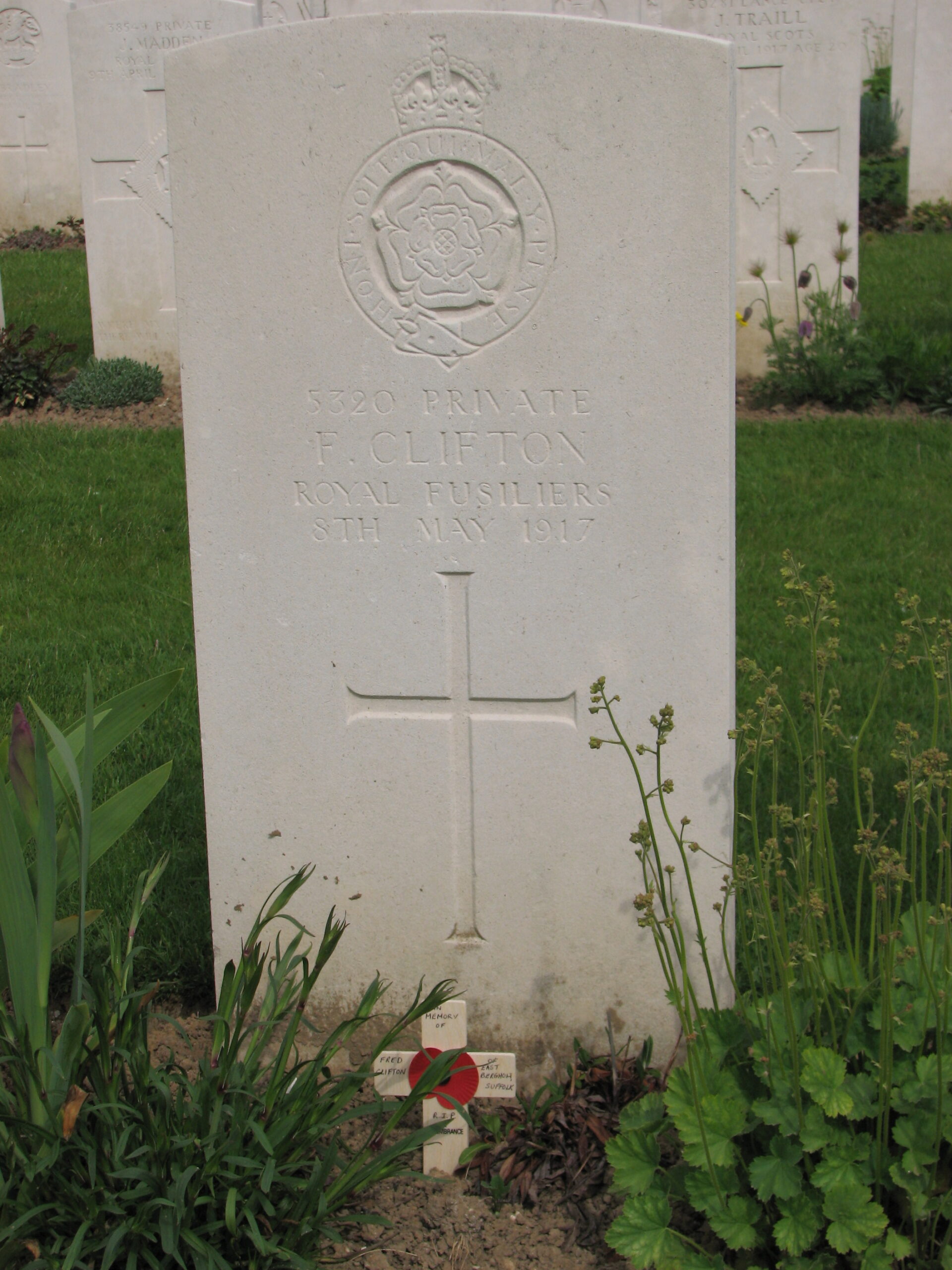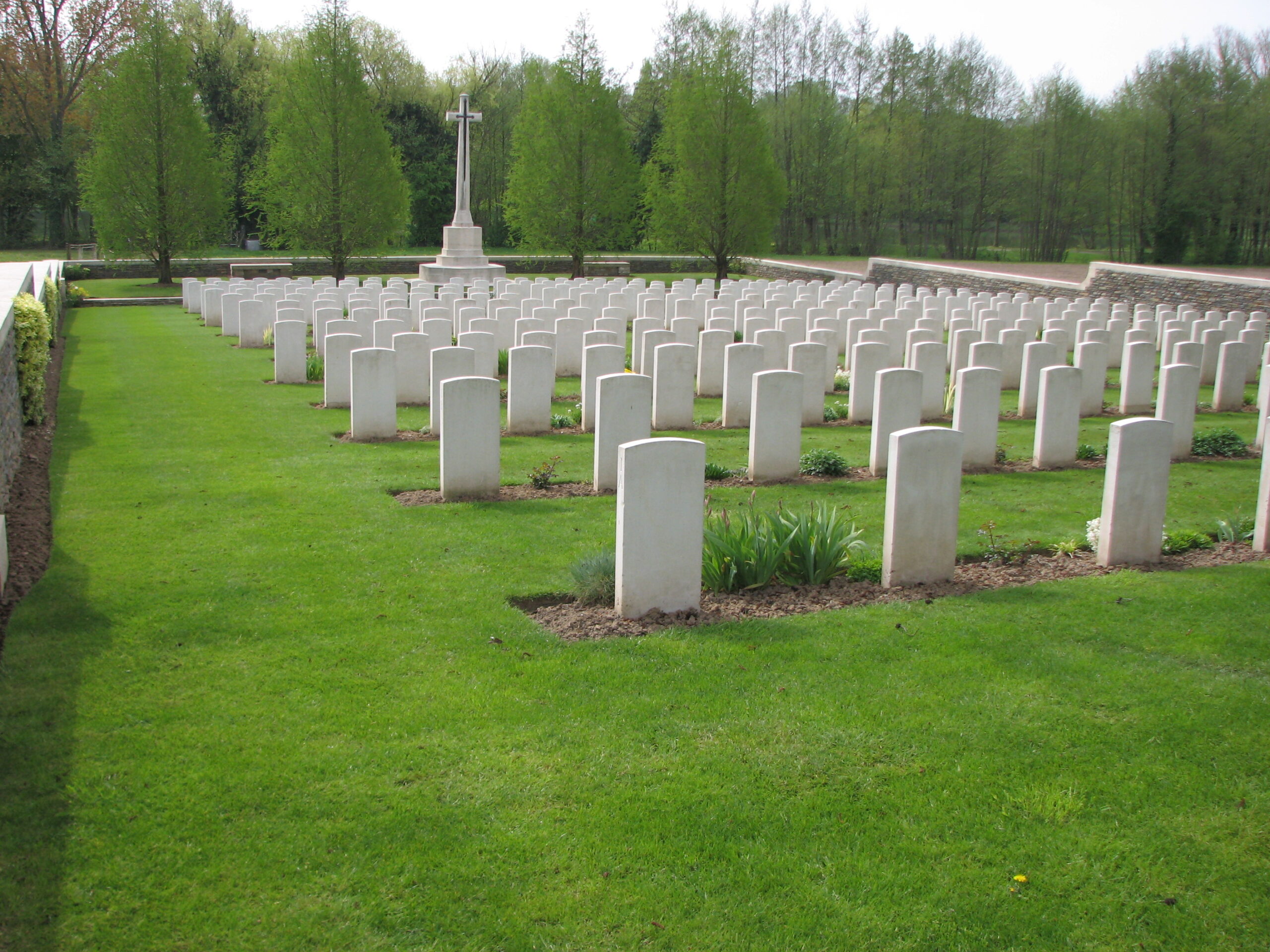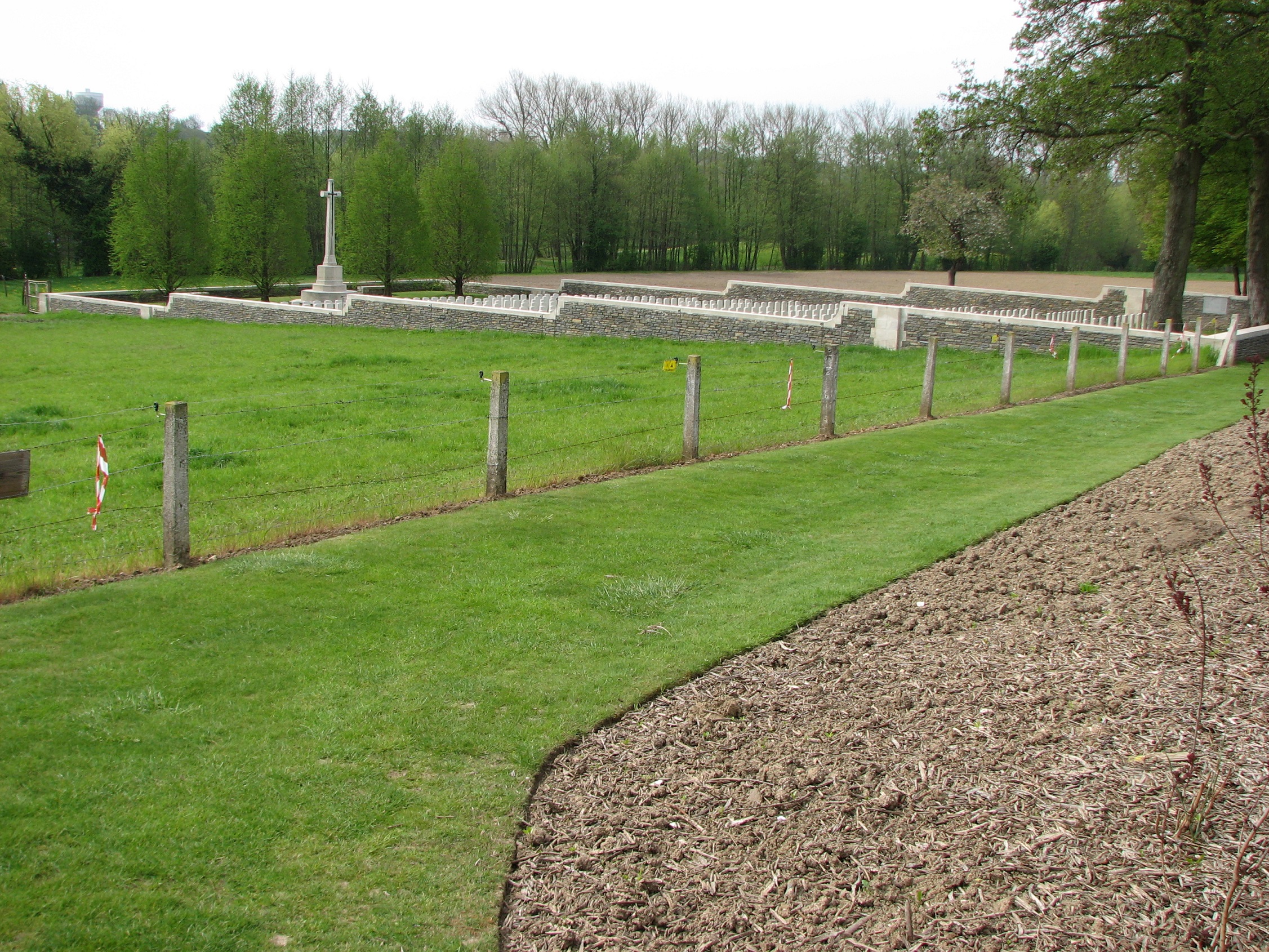Fred Clifton (1892 - 1917)
Brother of Max Clifton. Fred volunteered to join the Royal Fusiliers shortly after the outbreak of War and was wounded during the Gallipoli Campaign in 1915. He later served on the Western Front before being killed during the Battle of Arras.
- 22
- Died in the Great War
- 51.970051, 1.018515
Details
| Name: | Fred Clifton |
| Service: | British Army |
| Unit: | 8th Battalion, Royal Fusiliers |
| Regimental Number: | 5320 |
| Rank: | Private |
| Date of Death: | 8th May 1917 |
| Age: | 24 |
| Buried: | Row J, Grave 5, Ste. Catherine British Cemetery, Ste. Catherine, Arras, France |
Family Background and Early Life
Fred Clifton was born in East Bergholt on 17th November 1892, the third son of Maximillian and Susannah Clifton.
Maximillian – or Charles as he was also known – was originally from Wisbech, which at that time was in Norfolk. Charles appears to have spent some time as a Coachman in London, but later took up farming. His first wife died, and in 1888 he married Susannah Hill, from Holton St. Mary; Charles was 48 at the time, and Susannah was 25.
Charles and Susannah made their home in East Bergholt, where he was a Dairy Farmer (sometimes also referred to as Dairyman, or Milkman). It is not clear whether the Cliftons lived in just one residence in the village, as their address was variously described at the time as “near the Church”, “Church Walk”, “Rectory Hill”, “The Dairy” and “Brook Dairy”.
Charles and Susannah had at least 9 children together, including 6 boys and 3 girls.
Fred started at the village school at Burnt Oak corner on 17th April 1896, and remained as a pupil there for just over 10 years, leaving on 29th March 1906. Unfortunately, we know little of Fred’s civilian life after he left school, except that he appears to have left the village at some point before 1911. 1 Fred does not seem to appear on the 1911 Census for England and Wales and – so far – cannot be definitively identified on other records searched.
Gallipoli
We do know that Fred joined the Royal Fusiliers Regiment of the British Army, seemingly in September 1914 just one month after the outbreak of war between Great Britain and Germany.
In the late spring of 1915, Fred was posted to the Regiment’s 2nd Battalion which was at that time fighting the Turk on the Gallipoli Peninsula.
The Allied landings at Gallipoli were intended to gain control of the adjacent Dardanelles Straights, a move which – it was hoped – would lead to the capture of Constantinople, and encourage Germany’s ally, the Ottoman Empire, to sue for peace.
Since the initial Allied landings on the Gallipoli Peninsula in April, little progress had been made, and the campaign had deteriorated into a costly stalemate.
Fred arrived on the Peninsula on or around 16th June 1915, as part of a reinforcement draft. Within 6 weeks he had been wounded, perhaps during the 2nd Battalion’s successful attack against the Turkish trenches which took place on 28th June.
Evacuated from Gallipoli, Fred was back in Britain by the end of the year at the latest. By that time Fred was fit for duty, and early in 1916, he was sent to join the British Expeditionary Force (B.E.F.) in France.
France
On 8th February 1916, Fred was posted to his new unit, the 8th Battalion of the Royal Fusiliers. They had been in France since May of the previous year, as part of the 12th (Eastern) Division.
For the next 2 1/2 months, when the 8th Battalion were in the line, they were manning the trenches near the village of Vermelles, to the south-east of Bethune. In late April, they began a two month period of training, as they were one of the units selected to take part in the massive offensive planned to take place on the Somme.
The 8th Royal Fusiliers did not take part in the attacks on 1st July, the first day of the Battle of the Somme, but they were involved in some of the later fighting. On 7th July, they suffered high casualties from heavy German machine gun fire, during an attack on the fortified village of Ovillers.
In early August, the Battalion were sent north, but returned to the fighting on the Somme late the following month. On 7th October, as part of a larger attack against the German trenches near the village of Gueudecourt, the Battalion briefly gained its objective before being forced out, suffering 250 casualties in the process.
The 8th Royal Fusiliers left the Somme again at the end of October and spent much of the next 5 months in the area around Arras, rotating between time in the line and then in the rear.
The Battle of Arras
What has become known as the Battle of Arras began primarily as part of a joint offensive with the French. The British Army were to attack on an eleven mile front close to the town of Arras, whilst the French offensive took place 45 miles to the South. 2 The Battle of Arras was fought between 9th April and 16th May 1917. Some regard the Battle as one of the more successful offensives of the Great War, in large part because of the advances made in the first two days. However, in terms of average daily casualties, it was also the costliest offensive battle fought by the British Army during the Great War.
The offensive was launched on 9th April 1917, and the 8th Royal Fusiliers were in action just to the east of the town, gaining their objective, as did the 12th Division as a whole.
After 10 days in the rear, the Battalion moved back to Arras, where they were due to take part in a large attack on 3rd May. Their objective this time being the capture of the village of Pelves.
The attack started at 3.45 a.m., and without any support on either side, the 8th Royal Fusiliers and one other Battalion – managed to advance over 1000 yards into enemy territory – suffering heavy casualties as they went. A small group of the 8th even managed to reach the objective, but were either killed or captured. The Battalion suffered 280 casualties and were relieved 2 days later.
Fred is officially recorded as having been killed in action on 8th May 1917, aged 24. 3 The circumstances surrounding Fred’s death are rather unclear, not least because the Battalion were in Reserve at that time, and its War Diary for the 6th through to the 9th of May 1917 state that it did not suffer any casualties on those days. His body was buried where the Battalion were located on that day.
Postscript
Charles Clifton died exactly one month after Fred, at the age of 79.
In July 1919 Fred’s body was exhumed and reburied approximately 3 miles away in a small military cemetery on the outskirts of Arras, overlooking the River Scarpe. 4 This was as part of the move by the Imperial War Graves Commission (renamed the Commonwealth War Graves Commission in 1960) to concentrate isolated graves, as well as those in small French or German cemeteries, into larger, permanent cemeteries. He rests there still.
Susannah Clifton died on 3rd May 1945, aged 83. She was buried with Charles in East Bergholt Cemetery, where their gravestone also commemorates their two sons who died in the Great War: Fred and Max. 5 Of Fred’s 5 brothers, 4 served during the Great War:
Max served as a Sergeant in the 20th Battalion of the Australian Infantry Force. He was captured on 7th April 1918, and died of wounds 2 days later, aged 23.
Alec survived the War. He served as a Private in the Royal Army Medical Corps, and was captured by the Germans during the Battle of Cambrai in November 1917. Alec was awarded the Military Medal in March 1918.
Bob (the youngest brother) also survived the War, having served as a Private in The Queen’s (Royal West Surrey Regiment).
Jack survived the War, having served as a Private in the 1st Battalion of the Hertfordshire Regiment; he was captured by the Germans in April 1918.
Copyright © Mark Ashmore, 2024
- 22
- Died in the Great War
- 51.970051, 1.018515




